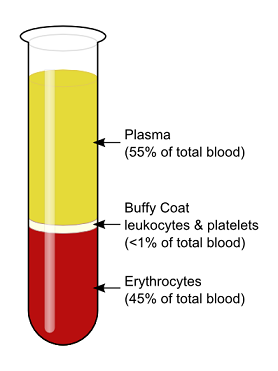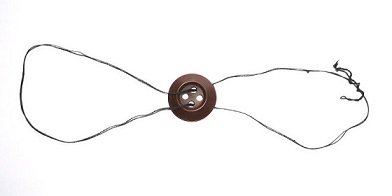Simple Engineering: A Centrifuge and a Microscope for less than $3!
Frequently the simplest method of doing things turns out to be the most efficient. In science and engineering, sometimes there is the tendency to think too deep or explore too much on things that have a simple solution.
Running a test for the varieties of samples such as cell cultures, urine and blood require the ability to isolate pathogens or DNA which will help identify the cause of the disease or ailment.

Blood after centrifugation. Image credits: By KnuteKnudsen CC BY 3.0 from Wikipedia Commons, Link]
The process requires the use of a centrifuge. Centrifuges are important in a test. For instance, in a blood testing, the blood is a composite made up of clear solution, plasma (55% of total volume), leukocytes (white blood cell) and platelets which forms less than 1% of the total blood volume and the erythrocytes or red blood cells (which constitutes the second largest component of the blood at 45% total volume).
Once the blood components are separated during the blood fractionation, through the centrifugal force of the centrifuges, it becomes easier to identify the red blood cells infected by malaria-causing parasites: Plasmodium falciparum and P. vivax from the female Anopheles mosquitoes as they are lighter.
The World Health Organisation (WHO) in November 2017 released an estimated mortality rate of 445,000 out of about 216 million world malaria cases. Out of these huge number of cases, the developing continent of Africa, the sub-Saharan region, account for 91% and 90% of malaria deaths and cases respectively.
But in the developing nations of the world
there is the problem in both accessing quality healthcare and affording the cost of laboratory centrifuges. The centrifuges are not cheap, a descent centrifuge costs more a thousand dollars. Even if the health workers somehow acquire it, there is the problem of lack of electricity to power the machine.
Where Physics Meets Biology in Frugal Science
M. Saad Bhamla, an Assistant Professor of Bioengineering, Stanford University, Stanford, California and Manu Prakash, an
Associate Professor Of Bioengineering at Stanford University decided to leverage on the already existing toy- the whirligig.

A button whirligig. Image credits: By Enic Public domain from Wikipedia Commons, Link]
The whirligig is a 5,000-year old toy which is simply made with a thread and a round object (button in the picture) with holes to pass the thread. By flipping the thread either in clockwise or anti-clockwise direction while holding the two ends of the thread, if you pull it an angular motion is induced in the button which allows it to spin very fast.
With this principle, the Paperfuge was inspired and created by the duo. The simple device was able to achieve speeds in excess of 125,000 rpm. You can watch this gif to see it in operation. Now the cost of this simple device is less than $1 at 20 cents.

A paper microscope or Foldscope CAD Layout. Image credits: By Cybulski J, Clements J, Prakash M [CC BY 4.0 ], via Wikimedia Commons from Wikipedia Commons, Link]
The Paperfuge produces up to 30,000 g of centripetal forces and cable of separating the plasma from the red blood cells in less than 1.5 minutes while weighing only 2g and most especially costs only a fifth of a dollar at 20 cents! There is no need for electricity to get this "toy" working. Some conventional centrifuges that cost more than one thousand times the value of this, averages between 4000rpm to 10,000 rpm.
But Prakash is not yet done, he and his team developed a less than a dollar microscope that can compete with the paperfuge in operation and low cost. The cheap microscope is already for sale at the cost of 20 pcs at $35, i.e at $1.75 each at Foldscope webiste.
Just like the last creation, it does not require electricity as it can be powered by a button cell battery, a tiny lens, and a paper assembled in a similar manner as we fold an origami. The microscope is capable of magnifying up to 140 times at a resolution of 2 microns!
So, armed with less than a $3 equipment, a doctor/health worker can transverse the rural villages and other areas without electricity while carrying out the test with the same result as a standard laboratory with the equipment that is bulkier, costlier, and requires electricity to run.
References
- Centrifuge
- Children's Whirligig Toy Inspires a Low-Cost Laboratory Test
- Whirligig
- Hand-powered ultralow-cost paper centrifuge
- Measure the Rotational Speed of a Toy
- This 20-cent whirligig toy can replace a $1,000 medical centrifuge
- Paper Microscope
If you write STEM (Science, Technology, Engineering, and Mathematics) related posts, consider joining #steemSTEM on discord here. If from Nigeria, there may be need to include the #stemng tag in your post. You can visit this blog by @stemng for more details. You can also check this blog post by @steemstem here and this guidelines here for help on how to be a member of @steemstem. Please also check this blog post from @steemstem on proper use of images devoid of copyright issues here
Would you like to delegate to the @steemstem? Here is a link below
50 SP | 100SP | 500SP | 1,000SP | 5,000SP | 10,000SP | 50,000SP

I've heard about it on tv once I believe! Indeed an amazing improvement. There were also other something similar regarding a microscope I believe.
Year I looked it up :D The "FoldScope" has a similar, simple and cheap design. I wonder what else people will come up with using this idea of designing.
I liked the simplicity and design, and to top it off it is functional and works!
This Paperfuge doesn't require any electricity to use...It only requires paper, a string, and some elbow grease and this is the more reason I like this biotechnique at least it will save cost of purchasing a standard centrifuge though I see paperfuge as something that if mal-handled it may likely malfuntion unlike the standard centrifuge that we use over here...its very old and its still working. Thanks to you for the awesome post.
Elbow grease? Yes, I agree it could be a pretty useful device.
Elbow grease just means human-powered. Like, if you are scrubbing pots and pans and there is burnt on food, someone will say "put some elbow grease into it," like, "scrub harder." ;)
Is that where the expression "more grease preferably power now) to your elbow" spring from? That's nice. Thank you.
Oh, I haven't heard that expression, but probably!
I read about the paperfuge somewhere but didnt think it was real....this advancement would really be of help especially here in Nigeria with our electricity issues.
nice work
Even if it's for use in classes as a teaching aid in Nigeria. That will be a welcomed development.
Science is miracle and that's simply awesome every time something new to learn from your blog :D
Thank you.
That is awesome!! I hadn't heard of this before!
Oh, that is nice. It can price rather helpful in developing nations such as ours that lacks some basic necessities with little cash to spare.
This post has been voted on by the steemstem curation team and voting trail.
There is more to SteemSTEM than just writing posts, check here for some more tips on being a community member. You can also join our discord here to get to know the rest of the community!
This is just amazing! It's great to see that scientists and engineers are creating cheap alternatives to scientific equipment. I'm curious to see what else will be created in the near future in terms of affordable lab tools and devices.